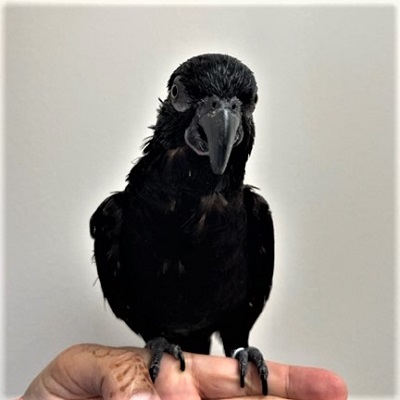
April is almost over and our Animal of the Month – the black lory – is flying out of the spotlight. While they look like they could be straight out of a tale spun by Edgar Allan Poe, if you were following us on Twitter @ExoticPetVets you will have learned that they are very friendly, gentle and engaging birds. If you missed any of our tweets throughout the month, you can find a summary of them right here. Did you know?:
- Black lories (Chalcopsitta atra) are medium-sized parrots native to West Papua, Indonesia.
- The first part of the black lories’ scientific name – Chalcopsitta – is Greek and translates into “bronze parrot.” “Khalkos” means bronze and “psitta” means parrot.
- The second part of the black lories’ scientific name is Latin with “atra” meaning black or dark.
- The black lory is also commonly known as the rajah lory and the red-quilled lory.
- So what is the difference between lories and lorikeets (who are also commonly called lories)? The answer lies in their tails and bodies.
- Lorikeets have slender bodies and long tapered tails. By comparison, the bodies of lories – including the black lory – are more stocky and their tails are shorter and blunt.
- In the wild, black lories are arboreal, which means they spend most or all of their time in trees.
- The black lory’s natural habitat includes tropical forests, mangroves, eucalyptus groves, savannas, and sparsely wooded grasslands. They can also be spotted in coastal coconut plantations.
- Because of their arboreal nature, black lories have strong legs and feet and can be seen hanging from branches sideways and upside down.
- When fully grown, black lories reach an average size of 12 – 12.5 inches (30 – 32 cms). Males and females look physically similar, although males can be slightly larger with larger heads and beaks.
- Black lories are unusual among parrots in that most of their feathers appear to be black. But they are not a true black as their feathers have a deep dark purple sheen to them.
- Black lories have black beaks and black feet. Their eye colour is a dark orange-red and they have a patch of bare dark grey skin around their eyes.
- The black lory tail is blunt and a medium-length. Compared to the dark body feathers, their tail’s underside looks like it was dipped in paint. It’s red and yellow and could be described as resembling a dancing flame or a sunrise.
- The black lory diet in the wild consists of nectar, pollen, fruits, berries, and blossoms.
- Because of their soft food and liquid diet, black lories have tiny hair-like appendages called papillae on the end of their tongues.
- The papillae are brush-like bristles and allow black lories to collect pollen and soak up nectar.
- Black lories – along with other lories and lorikeets – are sometimes referred to as brush-tongued parrots because of their brush-like tongues. It’s a unique characteristic that sets lories and lorikeets apart from other parrots.
- Black lories are messy. They eat a lot and are sloppy eaters. They also have a relatively short digestive tract, which means frequent droppings.
- Because of the high moisture content of their diet, black lories will produce loose and projectile droppings.
- Black lories are social birds and can be seen in the wild foraging for food in large flocks.
- While the number of black lories in the wild is unknown, they are listed as a species of “least concern” by the IUCN Red List.
- Black lories are a common sight in the wild and their population appears to be stable.
- Captive-bred black lories are known for being friendly, playful, affectionate and gentle when kept in captivity. But they are not pets suited for everyone.
- While black lories are good at mimicking human speech, they can be very loud. They also need a lot of attention and are easily bored.
- With proper care, black lories in captivity can live an average of 20-30 years.

